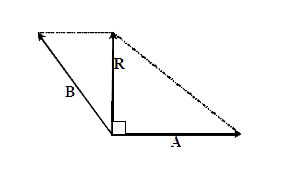If A and B are two vectors such that |A+B|=2|A-B|. The angle between vectors A and B is
45∘
60∘
30∘
data insuffcient
The correct Answer is:D
To solve the problem, we need to find the angle between two vectors →A and →B given the condition that |→A+→B|=2|→A−→B|.
1. Write down the given equation:
|→A+→B|=2|→A−→B|
2. Square both sides to eliminate the square root:
|→A+→B|2=4|→A−→B|2
3. Use the formula for the magnitude of a vector:
|→A+→B|2=→A⋅→A+→B⋅→B+2→A⋅→B
|→A−→B|2=→A⋅→A+→B⋅→B−2→A⋅→B
4. Substituting these into the equation:
→A⋅→A+→B⋅→B+2→A⋅→B=4(→A⋅→A+→B⋅→B−2→A⋅→B)
5. Expand the right-hand side:
→A2+→B2+2→A⋅→B=4→A2+4→B2−8→A⋅→B
6. Rearranging the equation:
0=4→A2+4→B2−8→A⋅→B−→A2−→B2−2→A⋅→B
0=3→A2+3→B2−10→A⋅→B
7. Dividing the whole equation by 3:
0=→A2+→B2−103→A⋅→B
8. Using the dot product in terms of the angle:
→A⋅→B=|→A||→B|cosθ
Substitute this into the equation:
0=|→A|2+|→B|2−103|→A||→B|cosθ
9. Rearranging for cosθ:
103|→A||→B|cosθ=|→A|2+|→B|2
cosθ=3(|→A|2+|→B|2)10|→A||→B|
10. Finding the angle θ:
Since the specific magnitudes of |→A| and |→B| are not provided, we cannot determine a specific numerical value for θ. Therefore, we conclude that the data is insufficient to find a unique angle.
Conclusion:
The angle between vectors →A and →B cannot be determined uniquely with the given information, hence the correct option is data insufficient.
|→A+→B|=2|→A−→B|
|→A+→B|2=4|→A−→B|2
|→A+→B|2=→A⋅→A+→B⋅→B+2→A⋅→B
|→A−→B|2=→A⋅→A+→B⋅→B−2→A⋅→B
→A⋅→A+→B⋅→B+2→A⋅→B=4(→A⋅→A+→B⋅→B−2→A⋅→B)
→A2+→B2+2→A⋅→B=4→A2+4→B2−8→A⋅→B
0=4→A2+4→B2−8→A⋅→B−→A2−→B2−2→A⋅→B
0=3→A2+3→B2−10→A⋅→B
0=→A2+→B2−103→A⋅→B
→A⋅→B=|→A||→B|cosθ
Substitute this into the equation:
0=|→A|2+|→B|2−103|→A||→B|cosθ
103|→A||→B|cosθ=|→A|2+|→B|2
cosθ=3(|→A|2+|→B|2)10|→A||→B|
Since the specific magnitudes of |→A| and |→B| are not provided, we cannot determine a specific numerical value for θ. Therefore, we conclude that the data is insufficient to find a unique angle.
The angle between vectors →A and →B cannot be determined uniquely with the given information, hence the correct option is data insufficient.
Topper's Solved these Questions
Similar Questions
vecA and vecB are vectors such that A +BI= I A -B j. Then, the angle between them is
View SolutionIf →a and →b are unit Vectors, then what is the angle between →a and →b so that √2→a−→b is a unit vector?
View SolutionIf →a,→b,→c are three vectors such that →a=→b+→c and the angle between →band→c is π2, then
View SolutionLet A,B and C be the unit vectors . Suppose that A.B=A.C =0 and the angle between B and C is π6 then prove that A=±2(B×C)
View SolutionLet A,B and C be the unit vectors . Suppose that A.B=A.C =0 and the angle between B and C is π6 then prove that A=±2(B×C)
View SolutionIf →a and →b are two vectors such that |→a|=∣∣→a×→b∣∣, write the angle between →a and →b.
View SolutionA=4i+4j−4kandB=3i+j+4k, then angle between vectors A and B is
View SolutionIf A and B are Two non -zero vector having equal magnitude , the angle between the vector A and A-B is
View SolutionIf →a and →b are two vectors such that |→a|=4,∣∣→b∣∣=3 and →a.→b=6 . Find the angle between →a and →b .
View SolutionThe resultant of two vectors A and B is perpendicular to the vector A and its magnitude is equal to half the magnitude of vector B. The angle between A and B is -
 View Solution
View Solution

